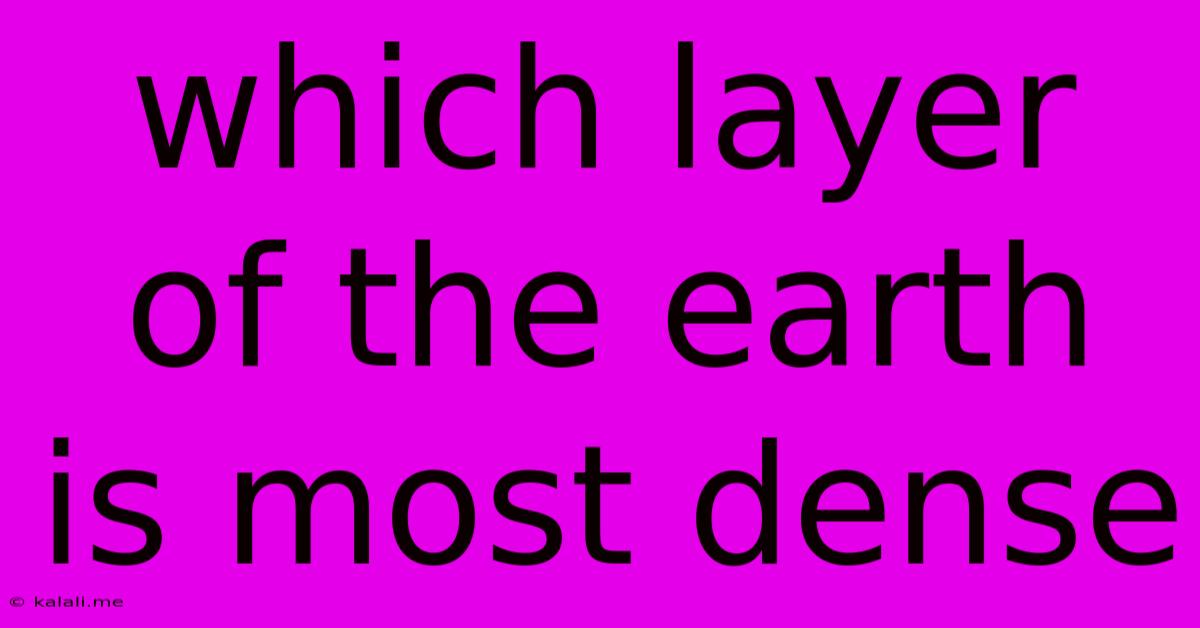Which Layer Of The Earth Is Most Dense
Kalali
May 10, 2025 · 3 min read

Table of Contents
Which Layer of the Earth is Most Dense? A Deep Dive into Earth's Interior
The Earth isn't a uniform ball of rock; it's a complex system with distinct layers, each with unique characteristics, including density. Understanding these differences is crucial for comprehending geological processes and the planet's overall structure. So, which layer is the densest? The answer is the Earth's inner core. This article will explore why, delving into the properties of each layer and explaining the factors contributing to density variations.
The Earth's internal structure is broadly divided into four main layers: the crust, mantle, outer core, and inner core. Each layer differs significantly in its composition, temperature, and pressure, leading to variations in density. Let's examine each layer individually:
The Crust: Earth's Brittle Outer Shell
The crust is the outermost and thinnest layer, consisting primarily of silicate rocks. It's relatively low in density compared to the other layers, with an average density around 2.7 to 3.0 g/cm³. The crust is further divided into oceanic crust (thinner and denser) and continental crust (thicker and less dense). This variation in thickness and composition accounts for some density differences within the crust itself.
The Mantle: A Viscous Layer of Silicates
Beneath the crust lies the mantle, a much thicker layer extending to a depth of approximately 2,900 kilometers. The mantle is primarily composed of silicate rocks rich in iron and magnesium. Although denser than the crust, with an average density around 4.5 g/cm³, it's significantly less dense than the Earth's core. The mantle’s high viscosity allows for slow convection currents, driving plate tectonics and volcanic activity.
The Outer Core: A Liquid Layer of Iron and Nickel
The outer core, extending from 2,900 kilometers to 5,150 kilometers, is a liquid layer primarily composed of iron and nickel. Its density is considerably higher than the mantle, averaging approximately 10 to 12 g/cm³. The liquid nature of the outer core is crucial for generating the Earth's magnetic field through a process known as the geodynamo. The high temperature and pressure within the outer core contribute to its fluidity and higher density.
The Inner Core: Earth's Dense, Solid Heart
Finally, at the Earth's center, lies the inner core. This is the densest layer, extending from 5,150 kilometers to the Earth's center at a radius of approximately 6,371 kilometers. Composed primarily of iron and nickel, its density is exceptionally high, estimated to be around 13 g/cm³ or even higher. The immense pressure at the Earth's center forces the iron and nickel atoms to pack incredibly tightly together, resulting in its extraordinary density. Despite the incredibly high temperature, the pressure is so great that the inner core is solid.
Factors Influencing Density: Pressure and Composition
Two primary factors contribute to the density variations between Earth's layers: pressure and composition. As you move deeper into the Earth, pressure increases dramatically. This compression forces atoms closer together, increasing the overall density. The composition also plays a crucial role. The inner core's high iron and nickel content significantly contributes to its density compared to the silicate-rich mantle and crust.
In conclusion, the inner core is definitively the densest layer of the Earth, owing to the immense pressure at its depth and its high iron-nickel composition. Understanding the densities of the different layers is essential for a comprehensive understanding of our planet's dynamic processes and geological evolution.
Latest Posts
Latest Posts
-
No Noise When Trying To Start Car
Jun 01, 2025
-
How Do I Close Tabs On Android
Jun 01, 2025
-
What Should Dehumidifier Be Set At
Jun 01, 2025
-
How Long For Deck Paint To Dry Before Rain
Jun 01, 2025
-
Does Eleven Get Her Powers Back
Jun 01, 2025
Related Post
Thank you for visiting our website which covers about Which Layer Of The Earth Is Most Dense . We hope the information provided has been useful to you. Feel free to contact us if you have any questions or need further assistance. See you next time and don't miss to bookmark.